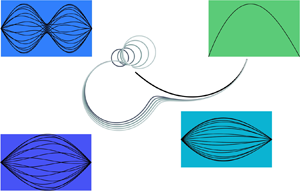Article contents
Unsteady aerodynamic theory for membrane wings
Published online by Cambridge University Press: 12 September 2022
Abstract

We study analytically the dynamic response of membrane aerofoils subject to arbitrary, small-amplitude chord motions and transverse gusts in a two-dimensional inviscid incompressible flow. The theoretical model assumes linear deformations of an extensible membrane under constant tension, which are coupled aeroelastically to external aerodynamic loads using unsteady thin aerofoil theory. The structural and aerodynamic membrane responses are investigated for harmonic heave oscillations, an instantaneous change in angle of attack, sinusoidal transverse gusts and a sharp-edged gust. The unsteady lift responses for these scenarios produce aeroelastic extensions to the Theodorsen, Wagner, Sears and Küssner functions, respectively, for a membrane aerofoil. These extensions incorporate for the first time membrane fluid–structure interaction into the expressions for the unsteady lift response of a flexible aerofoil. The indicial responses to step changes in the angle of attack or gust profile are characterised by a slower lift response in short times relative to the classical rigid-plate response, while achieving a significantly higher asymptotic lift at long times due to aeroelastic camber. The unsteady lift for harmonic gusts or heaving motions follows closely the rigid plate lift responses at low reduced frequencies but with a reduced lift amplitude and greater phase lag. However, as the reduced frequency approaches the resonance of the fluid-loaded membrane, the lift response amplitude increases abruptly and is followed by a sharp decrease. This behaviour reveals a frequency region, controlled by the membrane tension coefficient, for which membrane aerofoils could possess substantial aerodynamic benefits over rigid aerofoils in unsteady flow conditions.
JFM classification
- Type
- JFM Papers
- Information
- Copyright
- © The Author(s), 2022. Published by Cambridge University Press
References
- 7
- Cited by



